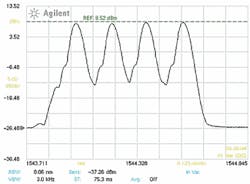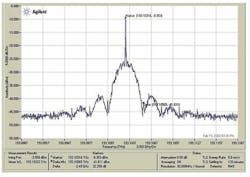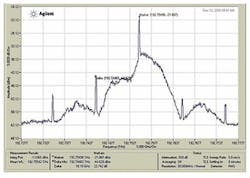Swept coherent heterodyne techniques provide high resolution
Val McOmber
For years, microwave engineers have used frequency-domain tools such as electrical spectrum analyzers to verify proper operation and analyze problems of high-frequency networks. Similarly, optical engineers have used optical spectrum analyzers (OSAs) to measure parameters in optical networks. Although OSAs help to get the larger picture on optical components and lasers, they lack the resolution needed for use in modulation and signal analysis. Signal analysis has been relegated to time-domain tools such as the digital communication analyzer, used for eye-pattern and bit-error-rate analysis.
As optical-bandwidth demands increase, channel spacing on wavelength-division-multiplexing (WDM) systems are narrowing from 200 GHz—which OSAs can easily distinguish—to spacings of 25 GHz or less, which strain the limits of the best OSAs. In addition to dense channel spacing, the modulation on each channel is increasing past 10 to 40 GHz and beyond, causing increased measurement difficulty.
Swept coherent-heterodyne mixing
Optical designers would benefit from the same kind of frequency-domain tool long used by radio-frequency (RF) designers—the spectrum analyzer. While a full-featured spectrum analyzer that can measure over the whole optical spectrum of interest with the same precision as an RF spectrum analyzer is not yet a reality, a first entry has been made into this high-resolution area of spectrometry. This new analyzer uses swept coherent-heterodyne-mixing techniques.
Using a swept-tuned optical local oscillator with a balanced optical receiver, coherent optical-spectrum analysis offers spectral resolution hundreds of times greater then conventional diffraction-grating-based optical spectrum analyzers. Other higher-resolution analyzers based on tunable Fabry-Perot filters have been tried, but they have not been popular—perhaps because of their intrinsically poor optical-filter shape that limits the dynamic range of the measurement. Heterodyne measurement techniques demonstrate higher resolution and dynamic range.
In a high-resolution spectrometer (HRS) using swept coherent-heterodyne mixing, the input signal is combined with a tunable narrow-linewidth reference—the local oscillator (LO; see Fig. 1). The LO is continuously swept without mode hops across the desired measurement range. The two combined signals are then split and applied to a balanced mixer. The actual mixing of the signals is done by the photodiode and its square-law effect. Optical mixing in the photodiode provides measurement of the input optical-field strength as the LO tunes across the desired wavelength range. The optical spectrum is determined from the square of the field measurement, providing sum and difference frequencies of the applied optical fields.1
The intensity at the coupler output has both in-phase- and desired anti-phase-mixing beat terms. By subtracting the photocurrent of the two photodetectors, the direct-detection components are removed, leaving the desired heterodyne signal, which is then filtered with a fixed bandwidth filter, amplified, and digitized for digital signal processing (DSP).
Polarization concerns
To achieve maximum amplitude, the polarization states of the desired signal and LO must be aligned for maximum interference at the coupler and photodetector. Signals that are not aligned will reduce the desired effect, resulting in an apparent signal loss. Because the LO is a tunable laser that has a high degree of linearly polarized light, any change in the polarization of the incoming signal will cause a change in the measured amplitude. Simple movement of a standard optical fiber causes large polarization fluctuations. To avoid this amplitude fluctuation, a polarization scrambler is added to the LO output, causing it to travel through all states of polarization. As long as the LO is sweeping slowly enough to allow the scrambler to provide a light source with the same state as the signal under test for each data point, the maximum signal output will be produced. The DSP selects the maximum information for each data point, allowing for calibration of amplitude and determination of the amplitude of the unknown signal.
The last key element in this high-resolution system is to know exactly where the sweeping LO is in frequency (or wavelength) for each and every data point sent to the DSP. Wavelength control and precise LO movement are critical for the signal frequency (wavelength) position. Together, the wavelength control, polarization scrambling, balanced mixing and subtraction, amplitude calibration, and digital signal processing allow for the complete display of the desired signal on either a frequency or wavelength scale with resolutions of a few megahertz—for example, seeing 20-MHz data on a 194-THz signal is possible.Zoom capability
This heterodyne system has the ability to view various resolutions, providing the ability to zoom in to examine any of the signals in a WDM system and view the modulation present on each one. The resolution limit—or zoom capacity—arises either from the limit of the post-detection filter of the system or the linewidth of the LO, whichever is wider. With such a zoom capability, the HRS can determine whether the signal has the desired symmetry and spectral content, or whether there is excessive chirp.With sufficient accuracy on the wavelength axis, the correct position on the International Telecommunications Union (ITU) grid can be checked and the true optical-signal spacing seen. Optical signals with subcarrier modulation can be examined on the optical channel without the need for detection systems that are not part of the actual network or optical transmission path. The spacing of the subcarriers can be determined and carrier-to-modulation ratios observed.
While the basics of optical heterodyne mixing are not new, the ability to do swept optical-heterodyne mixing with sufficient control of the sweeping light source opens the door for the next generation of optical-spectrum analysis. Not only can the optical community use the HRS for signal analysis, but the same heterodyne technique could find its way into the network, removing the need for precision fixed-tuned sources and filters. Static wavelength control would become dynamic; a local oscillator could dynamically track incoming signals while maintaining optimum spacing and signal strength. In addition, higher sensitivities may be possible. Until then, HRS offers the ability to measure today's optical signals and the increasingly complex modular schemes.
REFERENCES
1. D. M. Baney, et al., IEEE Photon. Technol. Lett. 14(3), 355 (March 2002).
2. Nazarathy et al., IEEE J. Lightwave Technol. 7(7), 1083 (1989).
VAL McOMBER is a product specialist at Agilent Technologies, 3910 Brickway Blvd., Santa Rosa, CA 95403; e-mail: [email protected].




